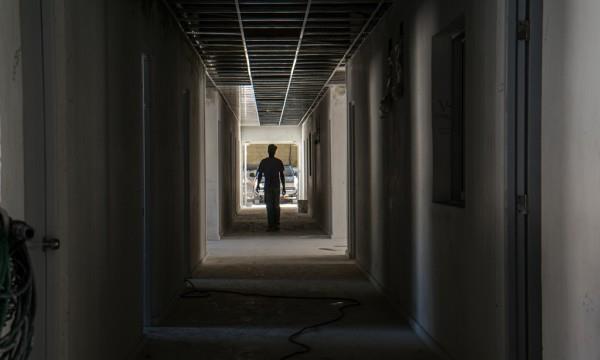Hospitals under pressure

ZONA FRONTERIZA.- The five frontier provinces contain more than 320,700 persons, or 3.4% of the national population. The hospitalS that attend these inhabitants all have something in common: they lack sufficient specialists and nurses, and spend part of their budget in service to Haitian immigrants.
"The doctors don't want to leave the capital," said Ramon Socrates Mancebo, the director of the Doctor Elio Fiallo General Hospital, in Pedernales. The provincial center which he directs is being remodeled by the government, the same as those of Independencia, Elias Piña and Montecristi. He told reporters that if they are inaugurated, and keep the same amount of personnel, services will not improve. In addition, there is a dilemma because a part of the nurses are at retirement age.
"We do not have a surgeon, we do not have an orthopedist," he complains. When a patient in Pedernales requires surgery, he has to be referred to Barahona, some 120 km away by highway.
In the case of the Ramon Matias Mella Provincial Hospital in Dajabon, the center has a perinatal room that is underused because there is no perinatal specialist.
The General Health Law 42 - 01 contemplates the establishment of a series of incentives, based on criterias of distance. The Director of the Payroll of the Ministry of Public Health indicated to the Diario Libre that for the frontier the interns required by law receive RD$1300, general doctors RD$2200 and specialists and postgraduate residents RD$3000 in incentives.
The lack of specialists is complicated by the need of supplies. The rural clinic at Juancho, in Pedernales, which is waiting for its remodeling, lacks basic utensils such as a stethoscope or a glucometer, forcing the interns to use their own equipment. The personnel also have to request donations of cleaning supplies from the schools and the neighbors.
In Juan Santiago, Elias Piña, nurse Colombia Ogando attends an average of 45 patients a day in a small locale. A little tired, she says that the facility lacks equipment for minor surgery which would permit them to perform sutures of up to 10 stiches. "Look in this shack where we are," she says, referring to the doctor's office that she occupies, where there is a woman stretched out on a bed with her two grandchildren playing on the floor.
Foreigners arrive with complications
Because it is close to Haiti and the immigration flow from that country, the health facilities attend foreign patients with illnesses at complicated stages or pregnancies without regular checkups, which raises the cost of treatment.
The Ministry of Public Health reports that between 2013 and 2014, the attentions to foreigners - in the great majority Haitians - at 16 frontier hospitals, represented 11.8% of the more than 2.1 million services provided, which included emergencies, consultations, hospitalizations, births, C-sections, surgeries, lab tests, transfusions and deaths.
Just deliveries and C-sections totaled 15,866, and 33.8% were foreigners. One Wednesday afternoon, in the postnatal room of the Rosa Duarte Provincial Hospital, in Elias Piña, there were five women laying on a equal number of beds: four were Haitian.
Since 2007 - when the Central Electoral Board enacted the Book of Foreigners - until April 2015, in the civil registry offices of the frontier provinces they have registered 2319 births of children of Haitian parents, 53.9% of them in Montecristi.
Puro Abreu, the director of the hospital in Dajabon, estimates that the center spends as much as 35% of its monthly budget of RD$475,000 on attention to Haitians. In 2014 they attended 2253. Given the demand, the doctor feels that they should construct another health center in Loma de Cabrera, which is 20 km to the south.
Antonio Faña, the manager of community health for Elias Piña, indicates that HIV and tuberculosis have a presence within the Haitian population which is greater than what is present in the Dominican population of this province. The same thing occurs in Independencia.
Just in 2012, the State spent RD$1.3 billion on foreign patients at the national level, with an average expenditure of RD$1676 for each one of them. The investment in this population represented 3.87% of the expenditures by the Ministry of Health in that year. In 2013, the investment increased to RD$2.84 billion.
At the end of 2014, the Minister of Public Health, Altagracia Guzman Marcellino, reported that she had received from the Chancellery the terms of reference for the construction of three health centers in an equal number of frontier passes, but on the Haitian side. She estimated that there are 3000 medical students in the Dominican Republic from Haiti who could practice medicine there.
"The doctors don't want to leave the capital," said Ramon Socrates Mancebo, the director of the Doctor Elio Fiallo General Hospital, in Pedernales. The provincial center which he directs is being remodeled by the government, the same as those of Independencia, Elias Piña and Montecristi. He told reporters that if they are inaugurated, and keep the same amount of personnel, services will not improve. In addition, there is a dilemma because a part of the nurses are at retirement age.
"We do not have a surgeon, we do not have an orthopedist," he complains. When a patient in Pedernales requires surgery, he has to be referred to Barahona, some 120 km away by highway.
In the case of the Ramon Matias Mella Provincial Hospital in Dajabon, the center has a perinatal room that is underused because there is no perinatal specialist.
The General Health Law 42 - 01 contemplates the establishment of a series of incentives, based on criterias of distance. The Director of the Payroll of the Ministry of Public Health indicated to the Diario Libre that for the frontier the interns required by law receive RD$1300, general doctors RD$2200 and specialists and postgraduate residents RD$3000 in incentives.
The lack of specialists is complicated by the need of supplies. The rural clinic at Juancho, in Pedernales, which is waiting for its remodeling, lacks basic utensils such as a stethoscope or a glucometer, forcing the interns to use their own equipment. The personnel also have to request donations of cleaning supplies from the schools and the neighbors.
In Juan Santiago, Elias Piña, nurse Colombia Ogando attends an average of 45 patients a day in a small locale. A little tired, she says that the facility lacks equipment for minor surgery which would permit them to perform sutures of up to 10 stiches. "Look in this shack where we are," she says, referring to the doctor's office that she occupies, where there is a woman stretched out on a bed with her two grandchildren playing on the floor.
Foreigners arrive with complications
Because it is close to Haiti and the immigration flow from that country, the health facilities attend foreign patients with illnesses at complicated stages or pregnancies without regular checkups, which raises the cost of treatment.
The Ministry of Public Health reports that between 2013 and 2014, the attentions to foreigners - in the great majority Haitians - at 16 frontier hospitals, represented 11.8% of the more than 2.1 million services provided, which included emergencies, consultations, hospitalizations, births, C-sections, surgeries, lab tests, transfusions and deaths.
Just deliveries and C-sections totaled 15,866, and 33.8% were foreigners. One Wednesday afternoon, in the postnatal room of the Rosa Duarte Provincial Hospital, in Elias Piña, there were five women laying on a equal number of beds: four were Haitian.
Since 2007 - when the Central Electoral Board enacted the Book of Foreigners - until April 2015, in the civil registry offices of the frontier provinces they have registered 2319 births of children of Haitian parents, 53.9% of them in Montecristi.
Puro Abreu, the director of the hospital in Dajabon, estimates that the center spends as much as 35% of its monthly budget of RD$475,000 on attention to Haitians. In 2014 they attended 2253. Given the demand, the doctor feels that they should construct another health center in Loma de Cabrera, which is 20 km to the south.
Antonio Faña, the manager of community health for Elias Piña, indicates that HIV and tuberculosis have a presence within the Haitian population which is greater than what is present in the Dominican population of this province. The same thing occurs in Independencia.
Just in 2012, the State spent RD$1.3 billion on foreign patients at the national level, with an average expenditure of RD$1676 for each one of them. The investment in this population represented 3.87% of the expenditures by the Ministry of Health in that year. In 2013, the investment increased to RD$2.84 billion.
At the end of 2014, the Minister of Public Health, Altagracia Guzman Marcellino, reported that she had received from the Chancellery the terms of reference for the construction of three health centers in an equal number of frontier passes, but on the Haitian side. She estimated that there are 3000 medical students in the Dominican Republic from Haiti who could practice medicine there.


 Diario Libre
Diario Libre
 Diario Libre
Diario Libre